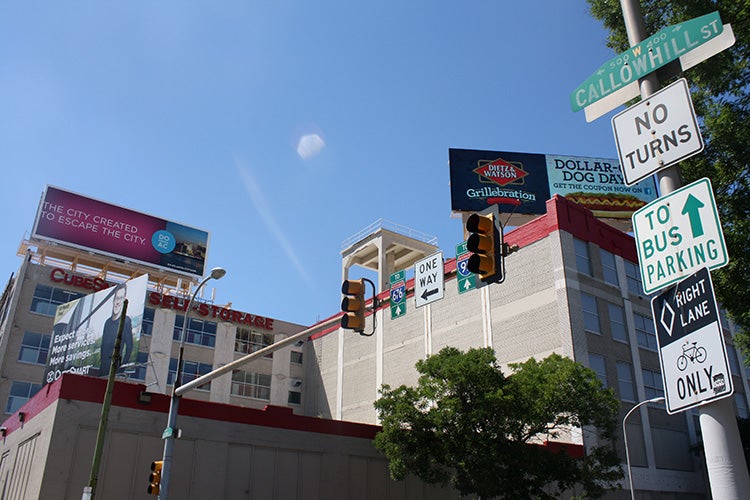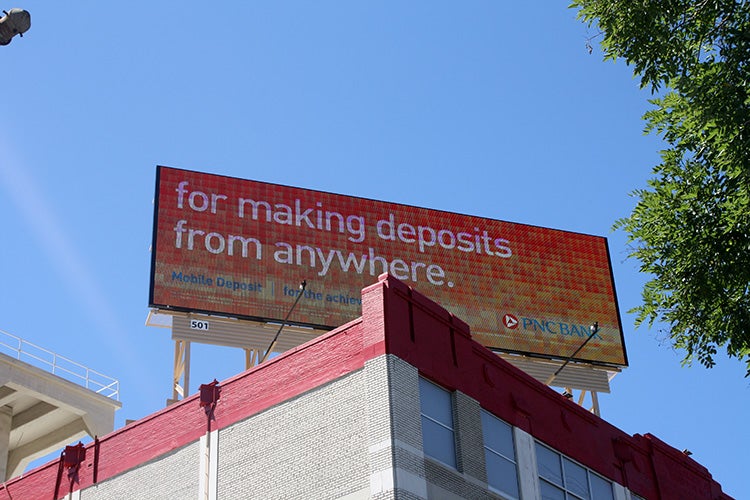Two zoning board hearings on digital billboard conversion continued
A hearing Wednesday afternoon at the Zoning Board of Adjustment regarding the proposed digitization of a billboard at 1933 West Moyamensing Avenue didn’t conclude so much as stop.
At the hearing, which was scheduled especially for the case, opposing attorneys presented for two hours—right up to the start of the next scheduled hearing. ZBA chair Lynette Brown-Sow asked the two sides to reschedule a time to continue the hearing.
Another hearing involving the same attorneys—Stephanie Kindt, representing neighbors opposed to digitization, and Stephen Pollock, representing the billboard owners—was rescheduled before it could begin. The latter case deals with an already-digital billboard at 400 North 5th Street, atop CubeSmart Self Storage.
The Moyamensing case revolves around an effort by Keystone Outdoor Advertising to demolish the existing, 62-foot, static billboard and replace it with a new, 90-foot billboard with one digital face. The advertising company first appealed L&I’s refusal of its application for a zoning variance last November.
The legal arguments presented at the hearing on the digitization of the Moyamensing billboard were complex and varied, but seem to revolve around whether demolishing and replacing the sign constitutes the expansion of a non-conforming use.
“This is a non-conforming use,” said Stephanie Kindt. “It’s crystal clear in the code, and it specifically addresses billboards. Billboards are meant to have a natural life. There’s legislative findings that talk all about – billboards are unsightly, that it detracts from the enjoyment and the historical character of the city, and the idea is to remove these nonconforming uses. So, when they argue that the sign can be demolished and rebuilt, it completely circumvents the entire intent of the code.”
The legislative findings Kindt refers to are found in section 14-1604 of the current zoning code, entitled “Outdoor Advertising and Non-Accessory Advertising Controls.”
Stephen Pollock, representing Keystone in the Moyamensing case, says the outdoor advertising section negates section 14-104, “Non-Conforming Uses and Structures,” and questions its validity. Section 14-104 allows for some existing nonconformities to be expanded. He described the proposed digitization of the billboard as a “modernization” of a use that’s been in place since the late 1960s.
Since the hearing was, again, continued, the ZBA did not weigh in on the merits of the case. It will ultimately decide whether or not to grant Keystone a zoning variance for the Moyamensing site, allowing it to demolish and rebuild the billboard.
In the case of the digital sign on North 5th Street, Kindt filed an appeal against a permit issued by L&I to allow the conversion of the billboard. She has filed a similar appeal against a permit issued by L&I for a digital billboard conversion at 1113 Vine Street. A hearing on that appeal will be held at the ZBA August 8, at 2 p.m.
Contact the reporter at jaredbrey@gmail.com and follow him on Twitter @jaredbrey
A hearing Wednesday afternoon at the Zoning Board of Adjustment regarding the proposed digitization of a billboard at 1933 West Moyamensing Avenue didn’t conclude so much as stop.
At the hearing, which was scheduled especially for the case, opposing attorneys presented for two hours—right up to the start of the next scheduled hearing. ZBA chair Lynette Brown-Sow asked the two sides to reschedule a time to continue the hearing.
Another hearing involving the same attorneys—Stephanie Kindt, representing neighbors opposed to digitization, and Stephen Pollock, representing the billboard owners—was rescheduled before it could begin. The latter case deals with an already-digital billboard at 400 North 5th Street, atop CubeSmart Self Storage.
The Moyamensing case revolves around an effort by Keystone Outdoor Advertising to demolish the existing, 62-foot, static billboard and replace it with a new, 90-foot billboard with one digital face. The advertising company first appealed L&I’s refusal of its application for a zoning variance last November.
The legal arguments presented at the hearing on the digitization of the Moyamensing billboard were complex and varied, but seem to revolve around whether demolishing and replacing the sign constitutes the expansion of a non-conforming use.
“This is a non-conforming use,” said Stephanie Kindt. “It’s crystal clear in the code, and it specifically addresses billboards. Billboards are meant to have a natural life. There’s legislative findings that talk all about – billboards are unsightly, that it detracts from the enjoyment and the historical character of the city, and the idea is to remove these nonconforming uses. So, when they argue that the sign can be demolished and rebuilt, it completely circumvents the entire intent of the code.”
The legislative findings Kindt refers to are found in section 14-1604 of the current zoning code, entitled “Outdoor Advertising and Non-Accessory Advertising Controls.”
Stephen Pollock, representing Keystone in the Moyamensing case, says the outdoor advertising section negates section 14-104, “Non-Conforming Uses and Structures,” and questions its validity. Section 14-104 allows for some existing nonconformities to be expanded. He described the proposed digitization of the billboard as a “modernization” of a use that’s been in place since the late 1960s.
Since the hearing was, again, continued, the ZBA did not weigh in on the merits of the case. It will ultimately decide whether or not to grant Keystone a zoning variance for the Moyamensing site, allowing it to demolish and rebuild the billboard.
In the case of the digital sign on North 5th Street, Kindt filed an appeal against a permit issued by L&I to allow the conversion of the billboard. She has filed a similar appeal against a permit issued by L&I for a digital billboard conversion at 1113 Vine Street. A hearing on that appeal will be held at the ZBA August 8, at 2 p.m.
Contact the reporter at jaredbrey@gmail.com and follow him on Twitter @jaredbrey
WHYY is your source for fact-based, in-depth journalism and information. As a nonprofit organization, we rely on financial support from readers like you. Please give today.







